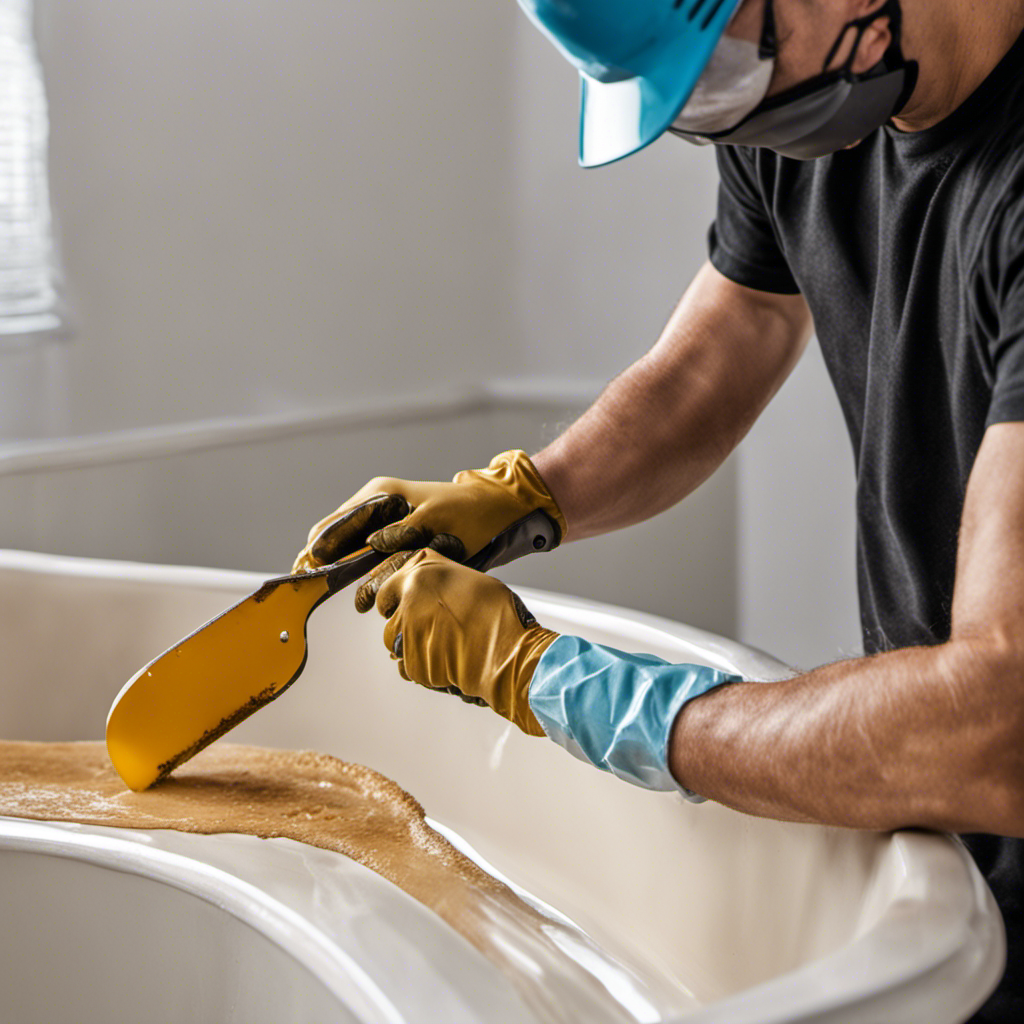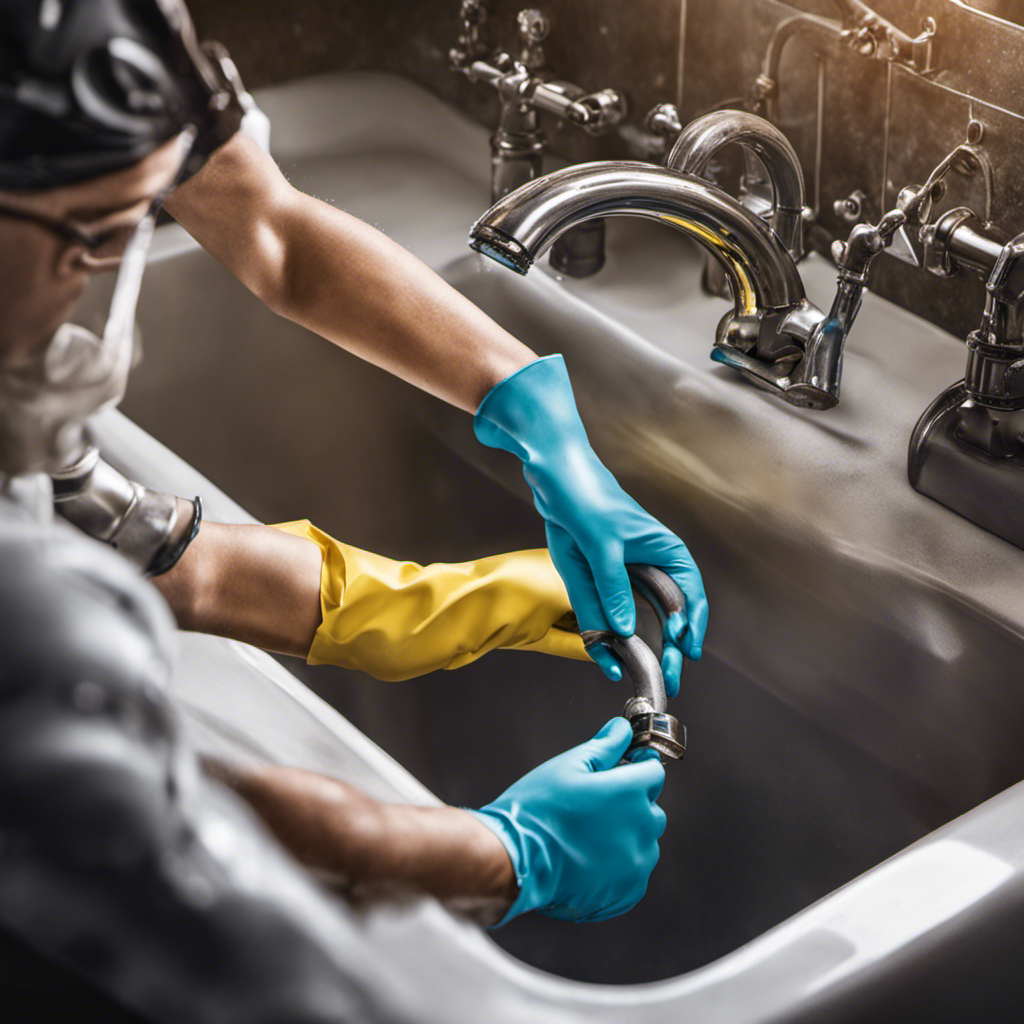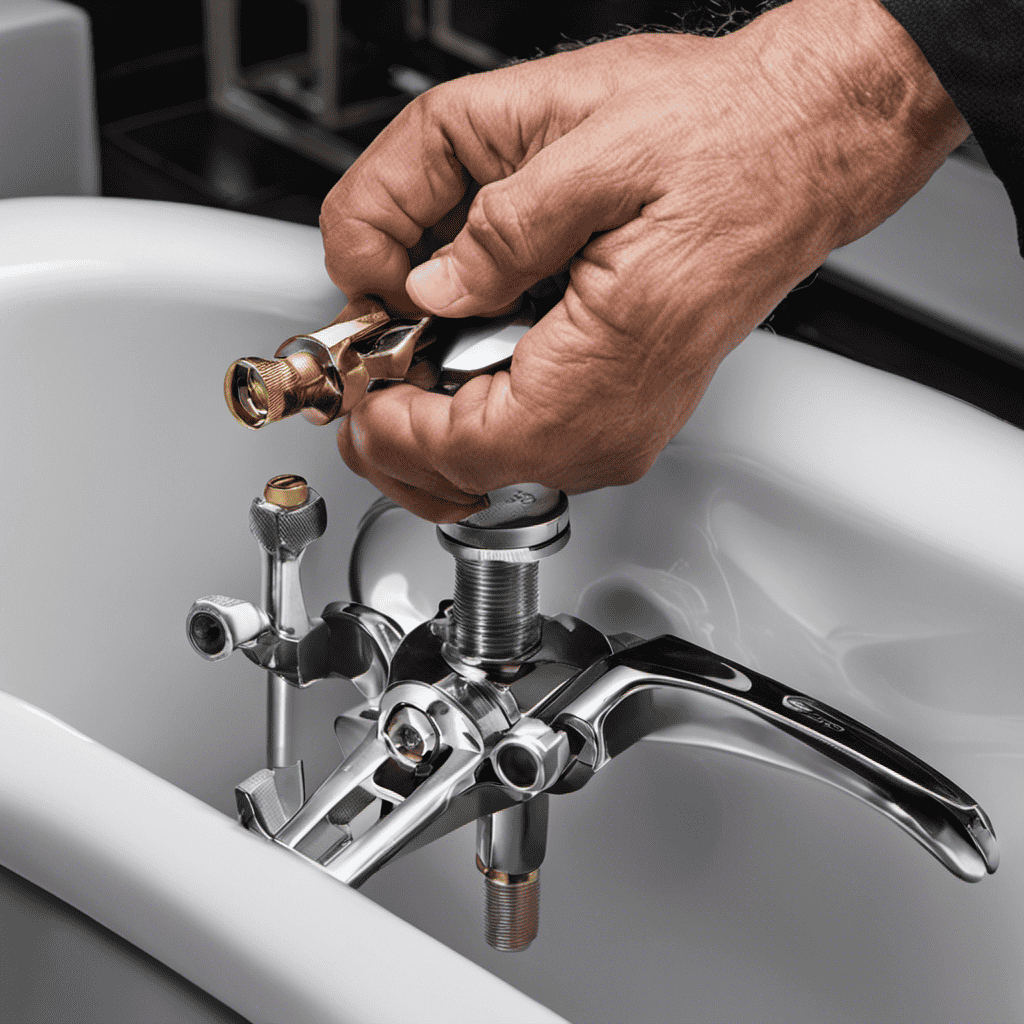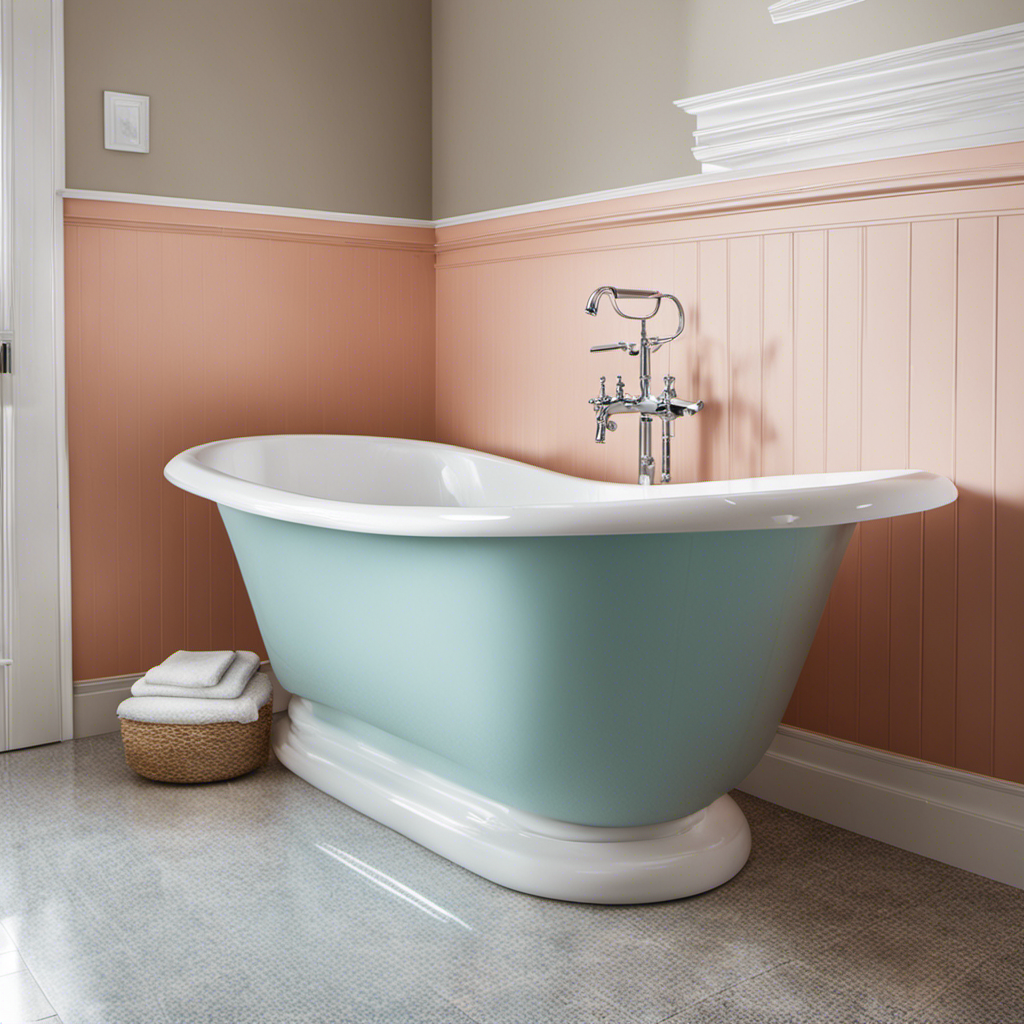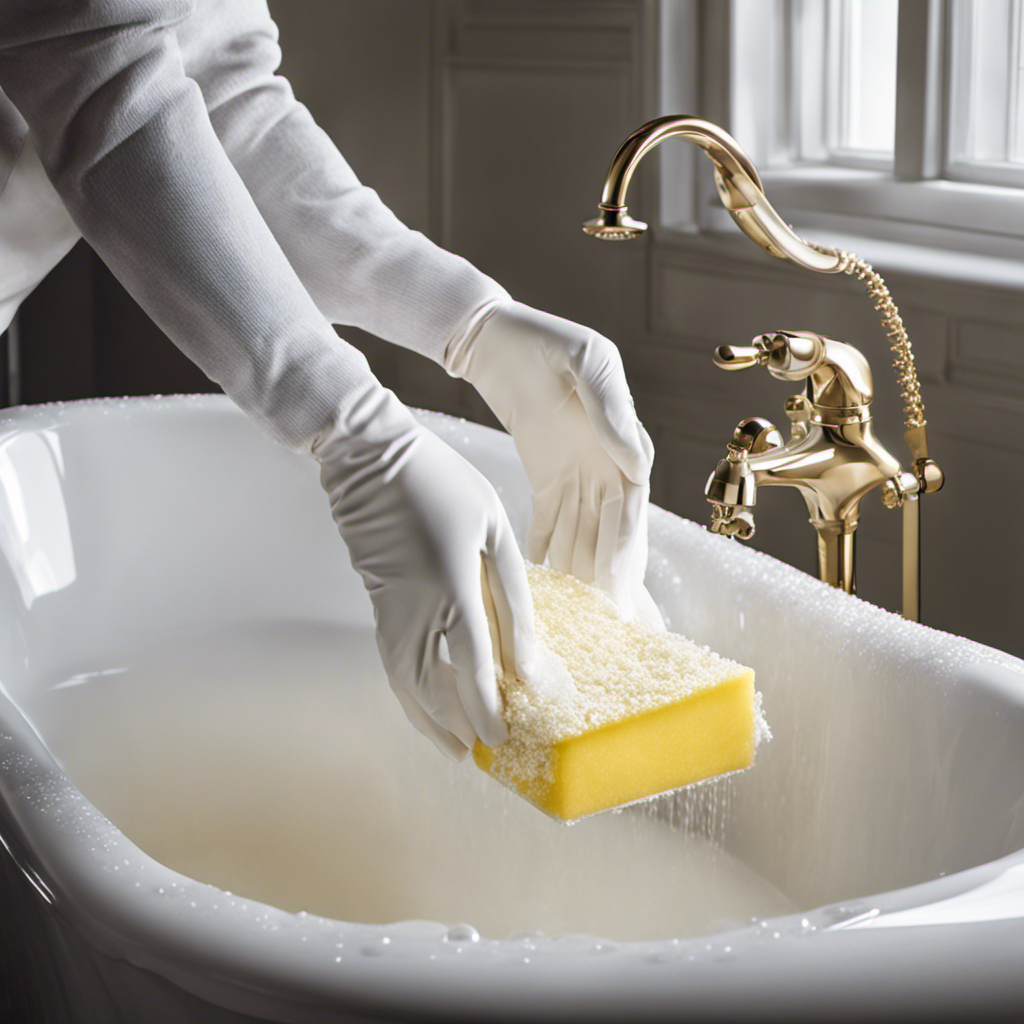Have you ever stepped into your bathtub only to discover an unsightly crack? Don’t panic – fixing a cracked bathtub is easier than you think!
In this step-by-step guide, we will show you how to:
- Assess the damage
- Gather the necessary tools and materials
- Prepare the bathtub surface
- Apply the repair solution
- Allow it to cure
- Sand and smooth the repaired area
- Seal and finish your bathtub
Get ready to restore your bathtub’s beauty and functionality in no time!
Key Takeaways
- Thoroughly inspect the entire bathtub surface for visible cracks or signs of damage.
- Use a flashlight to check for hidden cracks or leaks.
- Determine the cause of the crack to prevent future cracks.
- Clean and dry the surface of the bathtub before applying the repair solution.
Assessing the Damage
Before you can fix a cracked bathtub, you’ll need to assess the damage. Evaluating the extent of the crack is crucial in determining the appropriate repair method.
Start by thoroughly inspecting the entire bathtub surface, both inside and outside. Look for any visible cracks or signs of damage. Use a flashlight to check for any hidden cracks or leaks.
Next, determine the cause of the crack. It could be due to structural issues, temperature changes, or even improper installation. Understanding the cause will help prevent future cracks.
Measure the length and width of the crack to gauge its size accurately. Take note of any additional damage, such as chips or discoloration.
Once you have assessed the damage, you can proceed to the next step of fixing your cracked bathtub.
Gathering the Necessary Tools and Materials
Before diving into the bathtub repair process, it’s crucial to gather all the essential tools needed for the job. These tools may include a putty knife, sandpaper, epoxy resin, a mixing container, and a paintbrush.
Additionally, you will need to gather the required materials for the repair, such as a bathtub repair kit, fiberglass cloth, and a cleaner.
Essential Tools Needed
To fix a cracked bathtub, you’ll need a few essential tools. These tools will help you repair the crack and prevent any further damage to your bathtub.
One of the most common causes of bathtub cracks is the movement of the bathtub due to improper installation. Other causes include heavy impact or dropping heavy objects on the bathtub surface.
To repair these cracks, you will need a fiberglass repair kit, which includes resin and hardener, a paintbrush or roller for applying the resin, sandpaper for smoothing the surface, and a putty knife for spreading the resin.
Additionally, you’ll need a hairdryer or heat gun to accelerate the curing process of the resin.
These tools will ensure that you can effectively repair your cracked bathtub and restore it to its original condition.
Required Materials for Repair
To effectively restore your bathtub, you’ll need a fiberglass repair kit, a paintbrush or roller, sandpaper, a putty knife, and a hairdryer or heat gun. Bathtub repair kits are readily available in stores and online, containing all the necessary materials for fixing cracks and chips. These kits typically include epoxy resin, which is a strong and durable adhesive that will bond the cracked areas together. Epoxy resin is known for its excellent adhesion and waterproof properties, making it the ideal choice for bathtub repairs.
Additionally, using a paintbrush or roller, sandpaper, and a putty knife will help you prepare the surface and apply the repair materials smoothly. Gather everything before starting to ensure a seamless restoration process.
Gathering Everything Before Starting
Make sure you have all the necessary materials before beginning the restoration process. Gathering supplies and preparing your workspace are crucial steps in fixing a cracked bathtub. Here is a step-by-step guide to help you gather everything you need:
- Materials: Refer to the table below for a comprehensive list of required supplies.
| Quantity | Item | Purpose |
|---|---|---|
| 1 | Fiberglass repair kit | To fix the crack in the bathtub |
| 1 | Sandpaper | To smooth the surface before repairing |
| 1 | Safety goggles | To protect your eyes during the process |
| 1 | Gloves | To protect your hands |
| 1 | Respirator mask | To protect against harmful fumes |
- Workspace: Find a well-ventilated area with sufficient lighting. Clear the surrounding area of any obstructions and cover the floor with a drop cloth to protect it from any spills or debris.
Preparing the Bathtub Surface
First, thoroughly clean the bathtub surface to ensure proper adhesion of the repair material. Start by removing any soap scum, dirt, or grime using a non-abrasive cleaner and a sponge. Rinse the surface thoroughly with warm water to remove any residue.
Next, use a mild abrasive cleaner or a bathtub refinishing kit to remove any stains or discoloration. Scrub the surface gently using a soft brush or sponge, paying extra attention to the cracked area. Rinse the surface again to remove any cleaning product residue.
Finally, dry the surface completely with a clean towel or cloth. This step is crucial as any moisture left on the surface can prevent the repair material from adhering properly.
Proper bathtub cleaning and maintenance is essential to prolong the lifespan of your bathtub and prevent further damage.
Applying the Repair Solution
When applying the repair solution to your bathtub, it is important to use proper application techniques to ensure a successful outcome.
Begin by thoroughly cleaning and drying the surface of the bathtub, removing any debris or loose material.
Next, follow the manufacturer’s instructions to mix the repair solution and apply it evenly to the damaged area, using a brush or applicator.
Allow the solution to dry and cure according to the recommended time frame, ensuring a strong and durable repair.
Proper Application Techniques
To ensure a smooth and even application, start by preparing the crack in your bathtub. Follow these steps to properly apply the repair solution and prevent further damage:
-
Clean the crack: Use a mild detergent and a soft cloth to clean the crack and remove any dirt or debris. Make sure the area is completely dry before proceeding.
-
Apply the repair solution: Use a putty knife or a caulking gun to carefully apply the repair solution into the crack. Be sure to fill the crack completely and smooth out any excess solution.
-
Let it dry: Allow the repair solution to dry for the recommended amount of time specified by the manufacturer. This will ensure that the solution bonds properly and provides a strong, long-lasting repair.
Drying and Curing Process
After applying the repair solution, you’ll need to allow it to dry for the recommended amount of time to ensure a strong and long-lasting repair. Curing time is an essential step in the bathtub repair process, as it allows the repair solution to fully bond and harden.
The specific drying time will depend on the type of repair solution used, so always refer to the manufacturer’s instructions for accurate information. To expedite the drying process, you can use drying techniques such as using a hairdryer on a low heat setting or placing a fan nearby to increase airflow.
Avoid using the bathtub until the repair solution has fully dried and cured, as premature use can compromise the strength and effectiveness of the repair.
Allowing the Repair Solution to Cure
Once you’ve applied the repair solution, it’s important to let it cure properly. Curing time is crucial to ensure a successful repair and prevent any possible complications.
Here’s a step-by-step guide on how to allow the repair solution to cure effectively:
-
Follow the manufacturer’s instructions: Different repair solutions may have varying curing times, so it’s important to read and follow the instructions provided by the manufacturer.
-
Allow sufficient drying time: Ensure that the repair solution is given enough time to dry completely before using the bathtub again. This may typically range from 24 to 48 hours, depending on the product used.
-
Avoid water exposure: During the curing process, it’s essential to keep the repaired area dry. Avoid exposing it to water or any moisture, as this can interfere with the curing process and compromise the repair.
Sanding and Smoothing the Repaired Area
Now that the repair solution has fully cured, it’s time to move on to the next step: sanding and smoothing the repaired area.
This step is crucial in achieving a seamless finish. Start by using a fine-grit sandpaper, such as 220-grit, to gently sand the repaired area. Be sure to sand in a circular motion, applying light pressure. This will help to blend the repair with the surrounding bathtub surface.
As you sand, periodically wipe away the dust with a damp cloth to assess your progress. Once the repair feels smooth to the touch, switch to a finer grit sandpaper, such as 400-grit, for the final sanding. This will further refine the surface and prepare it for the finishing touches.
Sealing and Finishing the Repaired Bathtub
To achieve a polished look, you’ll want to seal and finish the repaired area of your bathtub. This will not only enhance the appearance but also protect the surface from further damage.
Here’s a step-by-step guide to sealing and finishing your repaired bathtub:
-
Clean the repaired area: Use a mild cleanser and a soft cloth to remove any dirt, debris, or residue from the repaired area. Ensure it is completely dry before moving on to the next step.
-
Apply a bathtub sealer: Choose a high-quality bathtub sealer that is waterproof and resistant to chemicals. Apply a thin layer of sealer over the repaired area, following the manufacturer’s instructions. Allow it to dry completely.
-
Finish with a bathtub refinishing kit: Use a bathtub refinishing kit to give the repaired area a smooth and glossy finish. Follow the instructions on the kit, applying multiple coats if necessary. Allow each coat to dry before applying the next.
By properly sealing and finishing the repaired area of your bathtub, you can ensure its longevity and prevent future damage.
Regular bathtub maintenance is crucial in maintaining its appearance and functionality.
Frequently Asked Questions
Can I Use Regular Household Glue to Fix a Cracked Bathtub?
No, you cannot use regular household glue to fix a cracked bathtub. There are alternative bathtub repair methods available that are more effective. Using household glue may result in further damage and is not recommended.
How Long Does the Repair Solution Take to Cure Completely?
To cure completely, the repair solution typically takes around 24-48 hours. However, keep in mind that curing time may vary depending on the specific product used. Also, there are alternative repair methods available.
Can I Use Any Type of Sandpaper to Smooth the Repaired Area?
To smooth the repaired area, you should use sandpaper with different grits. Start with a coarser grit to remove any roughness, then gradually switch to finer grits for a smoother finish. Alternatively, there are other bathtub repair methods available.
Is It Necessary to Wear Protective Gear While Applying the Repair Solution?
You must prioritize your safety when applying the repair solution by wearing protective gear. Neglecting this precaution could expose you to harmful chemicals and potential injuries. Be cautious and stay protected throughout the process.
Can I Use a Bathtub Immediately After Sealing and Finishing the Repaired Area?
You can use the bathtub immediately after sealing and finishing the repaired area. It is important to complete the bathtub repair quickly to ensure the seal is properly set and the area is safe for use.
Conclusion
Congratulations! You’ve successfully repaired your cracked bathtub and saved yourself from the hassle and expense of replacing it.
By following the step-by-step instructions and using the right tools and materials, you’ve restored your bathtub to its former glory.
Now, sit back, relax, and enjoy a long, soothing soak in your repaired bathtub. You can proudly say that you’ve conquered this challenge, just like a knight slaying a dragon!
